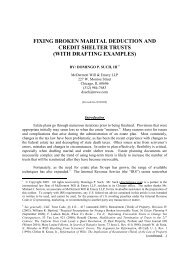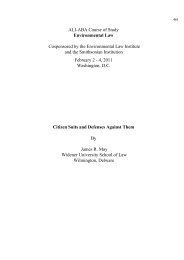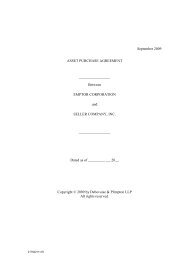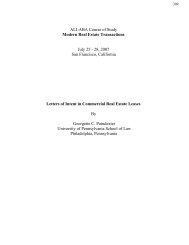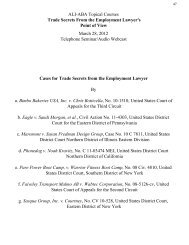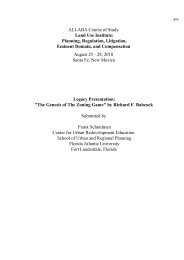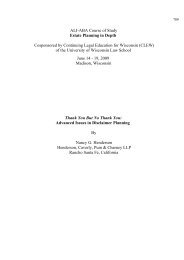ALI-ABA Topical Courses Trademark Law: What's New ... - ALI CLE
ALI-ABA Topical Courses Trademark Law: What's New ... - ALI CLE
ALI-ABA Topical Courses Trademark Law: What's New ... - ALI CLE
You also want an ePaper? Increase the reach of your titles
YUMPU automatically turns print PDFs into web optimized ePapers that Google loves.
10were included in an historic team in all versions and editions of the Madden NFL videogame sold since July 29, 2008, without permission or authorization.The Electronic Arts EA Madden NFL video game class action complaint reportedly allegesthat the only significant detail that EA changes from the real-life retired NFL player is theNFL players’ jersey number and that the video games is allegedly designed so that consumersof the Madden NFL game have no difficulty identifying who the historic players are (forexample, by position, years in the NFL, weight and height, relative skill level in differentaspects of the game, etc.).- from “Electronic Arts Class Action <strong>Law</strong>suit Filed Over EA’s Alleged Use Of RetiredNFL Players’ Likenesses In EA’s Madden NFL Video Game,” August 3, 2010, ©2010 Class Action <strong>Law</strong>suits In The <strong>New</strong>sO’Bannon v. NCAA[F]ormer UCLA power forward Ed O’Bannon is adding a new play to the book, which maymake it possible for former college athletes to get a slice of the licensing pie. After seeing afriend’s child playing a video game featuring classic teams, including the 1995 Bruins, andwith encouragement from Sonny Vaccaro, O’Bannon found himself wondering why he wasnot entitled to a share of the related revenues for the use of his likeness. In July 2009, theerstwhile first-round NBA draft pick filed his own class action lawsuit – O’Bannon v. NationalCollegiate Athletic Association and Collegiate Licensing Company – in the same court as Keller onbehalf of a narrower class than the one named in the Keller action. In O’Bannon, the allegedclass is limited to former student athletes who competed on Division I men’s basketballteams and Football Bowl Subdivision (formerly known as Division I-A) men’s footballteams. O’Bannon charges the NCAA and CLC with a broad slew of misuses of formerplayers’ indicia of identity beyond the gaming world, into “television contracts, rebroadcastsof ‘classic’ games, DVD game and highlight film sales and rentals, ‘stock footage’ sales tocorporate advertisers and others, photograph sales . . . and jersey and other apparel sales….”Importantly, rather than bring suit claiming violation of the right of publicity, O’Bannonalleges violations of antitrust law. According to O’Bannon, the NCAA and CLC areunreasonably restraining trade within the $4 billion annual market for collegiate licensedmerchandise. O’Bannon seeks an accounting of the defendants’ finances and to establish aconstructive trust that would hold the licensing revenues, which current college athletes –who are not permitted to be paid for their play to preserve amateurism – could access uponleaving college. The crux of O’Bannon’s complaint rests on Form 08-3a, a document thatthe NCAA requires prospective student athletes to sign in order to be eligible to play.According to O’Bannon, Form 08-3a is a “contract of adhesion” that requires young athletesto release in perpetuity their right to economically exploit their persona in connection withtheir collegiate athletic career and transfers this right to the NCAA’s or its third-partydesignees, who can use the student athlete’s name or picture to promote NCAA events,activities or programs.




